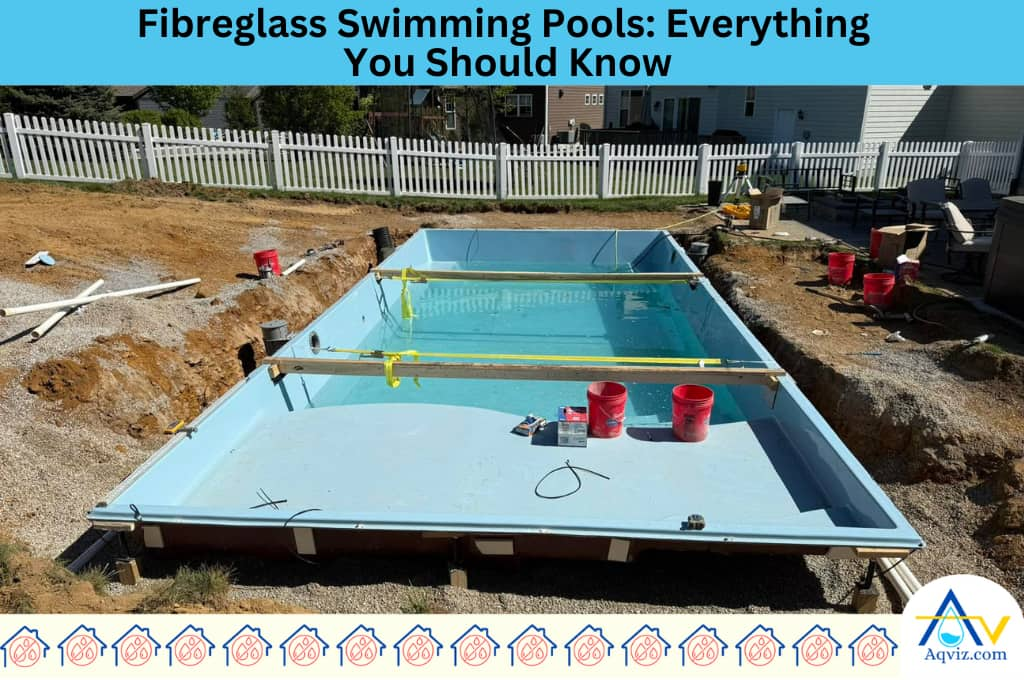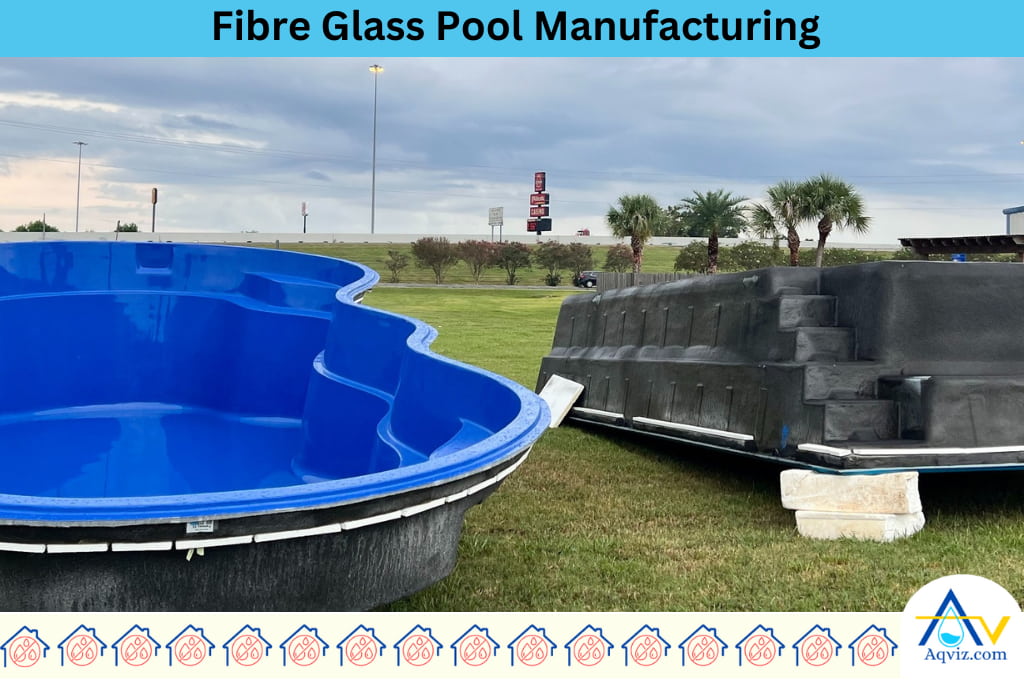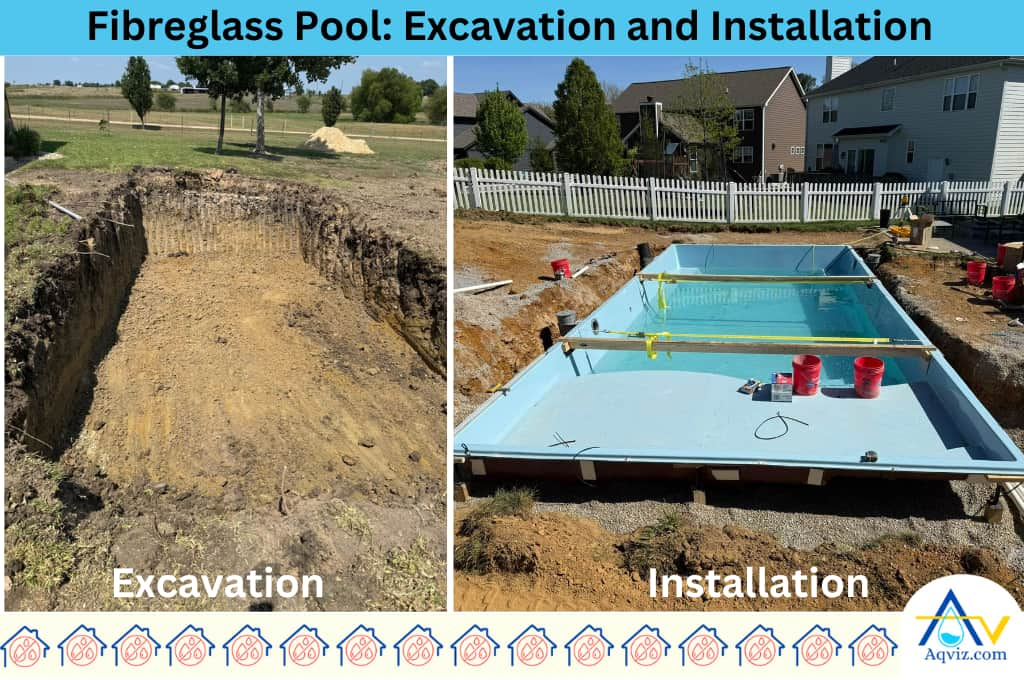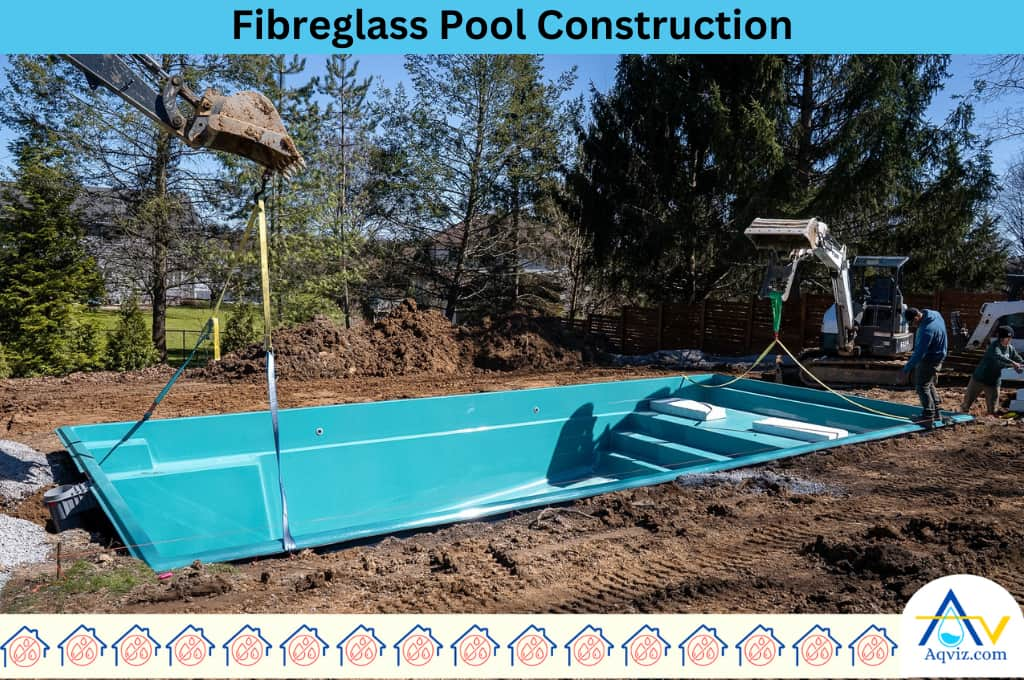Fiberglass Swimming Pools: Everything You Should Know

A fiberglass swimming pool is a one-piece, factory-molded shell manufactured using reinforced fiberglass and finished with a smooth gel coat surface. fiberglass swimming pools consist of 5 main layers. Among them, gelcoat layers are important because they provide a watertight barrier that resists algae growth, staining, and minor abrasions on the swimming pool.
fiberglass swimming pools are available in different size ranges, including depth, length, and shape. Normally, the average shell thickness of fiberglass swimming pools is between 3/8 inch (10 mm) and 1/2 inch (12 mm). Among them, the gel coat finish is between 0.5-0.7 mm, which acts as a waterproofing barrier against pool water.
A fiberglass swimming pool has a higher waterproofing capability. It has lower maintenance, fast installation, higher durability, flexibility, smooth comfort, and has a long lifespan. You can install a fiberglass swimming pool easily by following the steps below, Aqviz experts’ steps. To be honest, it is easier than building a concrete swimming pool. To control the uplift of the fiberglass swimming pools, you should install hydrostatic relief valves in the main drain to release groundwater pressure.
When you install a fiberglass swimming pool, you should use clean, angular gravel or 3/4 inch (19 mm) crushed stone because it compacts naturally, drains efficiently, and does not shift with groundwater movement. The cost of the fiberglass swimming pool ranges from $35,000 to $70,000 (including all tasks). If there is any damage, crack, or leak, you should repair the fiberglass swimming pools using fiberglass resin and mat.
A fiberglass swimming pool can be cracked due to improper installation, groundwater pressure, soil movement, structural overload, and material fatigue. These cause to cracks, leaks, and shape changes on the fiberglass structure. More than that, you can see algae growth, scaling, stains, foaming, and cloudy water as the problems of the fiberglass swimming pools.
Aqviz experts always recommend that you use a properly built fiberglass swimming pool. And use recommended products and methods when conducting repair and maintenance. As well as we highly recommend our groundwater controling techniques to prevent the uplift and external water problems in the fiberglass pool
What Is a Fiberglass Swimming Pool?
A fiberglass swimming pool is a one-piece, factory-molded shell manufactured using reinforced fiberglass and finished with a smooth gel coat surface. A fiberglass swimming pool consists of 5 main layers, including gel coat layer, vinyl ester resin, fiberglass laminate layer, core mat or honeycomb layer, and polyester resin support layer.
Among them, the gel coat of the fiberglass pool finish provides a watertight barrier that resists algae growth, staining, and minor abrasions on the swimming pool. As well as the fiberglass pool shell is seamless and built as a single structure, so homeowners avoid most common waterproofing concerns, such as joint leaks or liner punctures.
The rigid yet flexible nature of fiberglass allows it to adapt slightly to soil shifts, making it highly reliable against long-term cracking and water seepage. This balance of strength, flexibility, and low maintenance has made fiberglass pools a preferred option for DIY homeowners, contractors, and property managers.

What Sizes of Fiberglass Swimming Pools Are Available?
A fiberglass swimming pool is manufactured in various shapes, depths, and capacities to suit family needs and backyard layouts.
Standard size fiberglass swimming pool ranges from 4.5 meters (15 feet) to 12 meters (40 feet) in length, with widths between 2.5 meters (8 feet) and 5 meters (16 feet).
fiberglass pools’ depth typically starts at 1.2 meters (4 feet) for lounging and rises to 2.4 meters (8 feet) for diving designs.
These dimensions directly influence the number of people the pool can hold: small shells accommodate 4-5 users, while larger models serve 10–12 swimmers comfortably.
From our installations at Aqviz, we have seen kidney-shaped, rectangular, and freeform designs chosen to maximize person capacity without compromising garden space. Shallow-end of fiberglass swimming pool’s play zones work well for families with children, while deeper sections suit fitness enthusiasts and lap swimmers.
When homeowners select size, we recommend matching the fiberglass shell not only to person capacity but also to maintenance goals and soil conditions, as oversized pools often increase backfill requirements and hydrostatic pressure management.
How Thick Is a Fiberglass Swimming Pool?
A fiberglass swimming pool has an average shell thickness between 3/8 inch (10 mm) and 1/2 inch (12 mm), with reinforced areas around the steps, floor, and beam often reaching 3/4 inch (18 mm). Manufacturers use multiple layers of fiberglass mat, resin, and gel coat to achieve this uniform thickness. The gel coat finish itself is usually 20-30 mils (0.5-0.7 mm) thick, acting as the first protective waterproofing barrier against pool water.
From our projects at Aqviz, we’ve learned that thickness is directly connected to waterproofing and structural reliability. A thinner fiberglass shell risks osmotic blistering, flex cracks, and long-term water seepage, while an excessively thick shell can become brittle and hard to install.
Proper fiberglass thickness ensures the pool resists groundwater pressure, holds plumbing penetrations securely, and prevents leaks that could cause surrounding soil erosion or water damage in nearby structures. This balance of thickness and waterproofing integrity is what gives fiberglass pools their longevity and low-maintenance reputation.
What Are the Benefits of Fiberglass Swimming Pools?
There are 6 benefits of fiberglass swimming pools for homeowners and property managers.
- Superior waterproofing : The fiberglass swimming pools have a superior waterproofing capability due to the gel coat surface. The gel coat surface prevents water seepage, blocks algae growth, and minimizes the risk of leaks.
- Low maintenance : The fiberglass swimming pools reduce chemical demand because the smooth surface does not absorb water or harbor bacteria, making cleaning easier.
- Fast installation : The fiberglass swimming pools arrive as pre-formed shells, allowing installation to be completed in 1-2 weeks compared to months for concrete.
- Durability and flexibility : The fiberglass swimming pools resist cracking and structural stress because the material flexes with minor soil shifts and hydrostatic pressure.
- Smooth comfort : The fiberglass swimming pools provide a slip-resistant yet gentle surface that improves swimmer safety and comfort.
- Long lifespan performance : The fiberglass swimming pools maintain strength and appearance for 25-30 years with minimal repair, offering better value than vinyl or concrete pools.

How Do You Install a Fiberglass Swimming Pool?
Installing a fiberglass swimming pool requires careful planning, precise execution, and waterproofing knowledge. At Aqviz, we follow a proven process that minimizes leak risks and ensures long-term performance.
- Survey and mark the site: First you should survey and mark the site to install a fiberglass swimming pool by identifying utilities, confirming dimensions, and ensuring proper drainage slope to prevent groundwater accumulation.
- Excavate the hole: Second you should excavate slightly wider than the pool shell to allow for backfill and plumbing installation, keeping the base level and stable.
- Prepare the base: Then you should lay a 4–6 inch (100–150 mm) gravel bed to promote drainage and create a solid, even foundation.
- Set the fiberglass shell: Next you should lower the pool shell into the excavation using a crane, checking levelness across all sides and corners.
- Connect plumbing and fittings: After that you should install skimmers, drains, and return lines with waterproof gaskets and adhesives to secure leak-free operation.
- Backfill with gravel: Then you should backfill evenly around the pool while filling it with water simultaneously to balance pressure and prevent the shell from shifting.
- Finish the deck and coping: Finally, you should install concrete, pavers, or tiles around the pool perimeter with expansion joints and waterproof sealing.

How Do You Control Fiberglass Swimming Pool Uplift?
Fiberglass swimming pool uplift is the upward movement of the shell caused by hydrostatic pressure when groundwater builds up beneath the pool. This problem often occurs during rainy seasons, after flooding, or when the pool is drained for maintenance. If not controlled, uplift can push the shell out of the ground, crack plumbing, or damage the waterproofing system.
To control uplift in a fiberglass swimming pool, you should install hydrostatic relief valves in the main drain to release groundwater pressure. You should also use a gravel backfill with drainage pipes around the shell to keep water moving away from the excavation.
At Aqviz, we always advise homeowners never to fully drain the pool without professional supervision, since keeping water inside balances outside pressure and prevents uplift damage.
What Backfill Works Best Behind a Fiberglass Shell?
The best backfill for a fiberglass swimming pool is clean, angular gravel or 3/4 inch (19 mm) crushed stone , because it compacts naturally, drains efficiently, and does not shift with groundwater movement. Unlike sand or soil, gravel maintains consistent density, preventing settlement that can cause structural stress, leaks, or plumbing line breaks.
A fiberglass swimming pool requires backfilling material with free-draining properties, stability, and non-expansive characteristics. Clean gravel allows hydrostatic pressure to dissipate, reducing the risk of uplift and shell bulging.
At Aqviz, we avoid clay or fine sand because these materials trap water, expand when wet, and shrink when dry, which often leads to waterproofing failures and pool wall damage over time.
How Much Does a Fiberglass Swimming Pool Cost?
A fiberglass swimming pool typically costs between $35,000 and $70,000, depending on size, shape, and added features. The pool shell itself usually ranges from $15,000 to $30,000, with prices increasing for larger or custom designs. This upfront investment often pays off long-term because fiberglass requires less chemical use and fewer repairs than concrete or vinyl pools.
The total project cost also includes excavation ($5,000-$10,000), plumbing and electrical installation ($3,000-$7,000), and backfilling and setting the shell ($7,000-$15,000).
Finally, finishing with decking, coping, and landscaping ($5,000-$20,000) completes the installation. At Aqviz, we remind clients to budget for waterproofing drainage systems as well, since managing groundwater around the shell is critical to prevent uplift, leaks, and long-term water damage.

How Do You Repair Fiberglass Swimming Pools?
Repairing a fiberglass swimming pool requires a methodical approach to restore waterproofing and structural integrity. At Aqviz, we follow a proven 7-step process:
- Inspect the damage: First you should identify cracks, blisters, or leaks by draining the pool below the damaged area and marking weak spots.
- Sand the surface: Second, you should grind down the damaged gel coat and fiberglass layers to expose a clean, rough surface for bonding.
- Clean thoroughly: Then you should wash the area with acetone to remove oils, dirt, and contaminants that interfere with resin adhesion.
- Apply fiberglass resin and mat: Next, you should layer fiberglass mat with polyester or vinyl ester resin to rebuild the damaged section.
- Roll and cure: After that, you should use a roller to eliminate air bubbles, then allow the fiberglass patch to cure completely.
- Apply gel coat: Then you should match the original color and apply a waterproof gel coat layer to seal and protect the repaired area.
- Polish and test: Finally, you should sand and buff the surface smooth, refill the pool, and check for watertightness to confirm the repair is successful.
Why Do Fiberglass Swimming Pools Crack?
A fiberglass swimming pool can develop cracks when installation or maintenance conditions fail to protect the shell against stress and water pressure. From our repair work at Aqviz, we’ve identified the main causes:
- Improper installation: Uneven excavation or poorly compacted backfill creates pressure points that stress the shell.
- Groundwater pressure: Excessive hydrostatic pressure beneath the pool can push the shell upward, causing stress cracks.
- Soil movement: Expansive clay soils or freeze-thaw cycles shift the ground, leading to flex fractures in the fiberglass.
- Structural overload: Draining the pool without proper precautions removes balancing water weight, causing wall or floor cracks.
- Material fatigue: Low-quality resin or thin fiberglass layers weaken over time, increasing vulnerability to cracking.
Why Do Fiberglass Swimming Pools Leak?
A fiberglass swimming pool can leak when its waterproofing system or fittings are compromised. At Aqviz, we’ve tracked leaks to several common sources during repairs:
- Plumbing penetrations: Skimmers, return lines, and main drains often leak if gaskets and seals deteriorate or were poorly installed.
- Gel coat damage: Surface blisters or cracks in the gel coat allow slow seepage of water into the fiberglass laminate.
- Structural cracks: Stress fractures in the shell caused by soil movement or hydrostatic pressure become direct leak paths.
- Fitting joints: Lights, jets, and other cutouts can leak when bonding materials break down under water pressure.
- Beam and coping area: The top edge of the pool sometimes leaks where decking expansion joints are not properly waterproofed.
Read More About
What Are the Water Problems in Fiberglass Swimming Pools?
A fiberglass swimming pool is easier to maintain than concrete or vinyl, but water problems still occur if chemistry and waterproofing are neglected. Based on our service work at Aqviz, the most common water problems in the fiberglass swimming pool are listed below.
- Algae growth
- Scaling
- Staining
- Foaming
- Cloudy water
What Are the Stains on Fiberglass Swimming Pools?
The stains on a fiberglass swimming pool appear as discolorations on the gel coat surface and usually result from minerals, metals, or organic matter in the water. Common stains include brown or rust-colored marks from iron, green stains from copper, and black stains from manganese. These metals often enter the pool through fill water, corroded pipes, or worn pool equipment.
A fiberglass swimming pool also develops stains from organic debris like leaves, algae, or dirt that sit too long on the surface. When these materials decompose, they release tannins and pigments that bond to the gel coat. At Aqviz, we’ve often treated stains by balancing water chemistry, using metal sequestrants, and ensuring proper filtration so contaminants don’t settle and cause long-term discoloration.
Is a Fiberglass Swimming Pool Better than Concrete?
A fiberglass swimming pool is often better than a concrete pool when homeowners prioritize waterproofing, maintenance, and installation time. The non-porous gel coat surface of fiberglass prevents seepage, resists algae growth, and reduces chemical demand. In contrast, a concrete pool is porous, requiring frequent resurfacing and sealing to maintain waterproofing.
From our experience at Aqviz, fiberglass pools can also be installed in 1-2 weeks, while concrete pools can take 3-6 months.
Fiberglass shells provide flexibility against soil movement, reducing cracking risks, whereas concrete shells are rigid and more prone to structural cracks.
However, concrete offers more design freedom in shape and size. For most families seeking durability, cost efficiency, and low water maintenance, fiberglass swimming pools deliver better long-term value.
Is a Fiberglass Swimming Pool Better than a Vinyl Liner?
A fiberglass swimming pool is generally better than a vinyl liner pool in terms of durability, waterproofing, and long-term costs. The fiberglass shell has a seamless, non-porous gel coat that prevents leaks and resists algae growth. A vinyl liner, on the other hand, is vulnerable to punctures, tears, and seam failures, which can cause water loss and demand frequent replacement.
At Aqviz, we’ve seen vinyl liners last 7-10 years, while fiberglass pools often perform for 25-30 years with minimal repairs.
Vinyl liners may offer a lower initial cost, but liner replacements, resurfacing, and higher chemical demand add significant expense over time. For homeowners seeking strength, waterproofing reliability, and low maintenance, fiberglass swimming pools provide superior long-term performance compared to vinyl liner pools.
